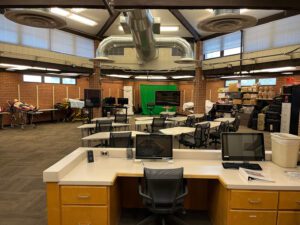Once you have the funding for your VR lab, you will need to set up the physical space.
Two experts weigh in on what it takes to keep the equipment in shape for the students. They have each set up VR labs of their own using VRpatients and have consulted on many others.
 |
Tracy Chesney, PhD(c), MSN-Ed, RN, CNE, CHSE, CHSOS, Nursing SME & Product Supervisor for VRpatients and the Vice-Chair of the Virtual Simulation Committee with the International Nursing Association in Clinical Simulation in Learning (INACSL). |
 |
Devin Marble, B.S., NRP, Educator for Immersive Technologies at VRpatients. |
No matter what type of VR lab you have, their advice is consistent.

Credit: Pima Community College
Have Things Ready to Go
The last thing you want is for your students to go into the lab and it isn’t ready for them.
“There are a few factors to think about – one is keeping the headsets charged. They only last for so long so you definitely have to charge them and clean them in between students,” Chesney says. “The size of your lab makes a difference of how quickly you can get that cleaning done.”
Chesney recommends special UV lights to clean the headsets and face shields.
Wiping down the controllers and keyboards is also a way to keep germs from spreading between users.
Have an Update Schedule
Chesney learned from experience to have a regular schedule to install any updates and check everything before a class is scheduled in the lab.
“Heaven forbid Windows decides to do an update. The last thing you want is for students to come in and not have things work.”
She was able to justify a full-time simulation operations specialist to handle all of the hardware and software maintenance.
“You need to make sure that you have somebody who actually stays up-to-date with everything. It’s not about just making sure Windows and the headsets are updated. It’s when a new version comes out, having someone to ensure everything functions together and is testing everything.”
Teach People to Troubleshoot
With Chesney’s second lab, she says she did a better job empowering faculty to know how to use the equipment.
“We got the faculty into the headsets, taught them now to understanding the cases and troubleshoot if a student needs help. If a student runs into something, it is better if the faculty has already experienced it.
Interested in learning more about VRpatients? Talk to our experts and request a demo.
